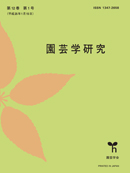Volume 12, Issue 1
Displaying 1-17 of 17 articles from this issue
- |<
- <
- 1
- >
- >|
REPORTS
Breeding & Germplasm Resources
-
2013 Volume 12 Issue 1 Pages 1-7
Published: 2013
Released on J-STAGE: April 01, 2013
Download PDF (831K) -
2013 Volume 12 Issue 1 Pages 9-14
Published: 2013
Released on J-STAGE: April 01, 2013
Download PDF (1528K) -
2013 Volume 12 Issue 1 Pages 15-22
Published: 2013
Released on J-STAGE: April 01, 2013
Download PDF (1229K) -
2013 Volume 12 Issue 1 Pages 23-28
Published: 2013
Released on J-STAGE: April 01, 2013
Download PDF (983K) -
2013 Volume 12 Issue 1 Pages 29-34
Published: 2013
Released on J-STAGE: April 01, 2013
Download PDF (736K)
Soil Management, Fertilization & Irrigation
-
2013 Volume 12 Issue 1 Pages 35-41
Published: 2013
Released on J-STAGE: April 01, 2013
Download PDF (582K) -
2013 Volume 12 Issue 1 Pages 43-49
Published: 2013
Released on J-STAGE: April 01, 2013
Download PDF (466K)
Crop Production & Cropping Type
-
2013 Volume 12 Issue 1 Pages 51-56
Published: 2013
Released on J-STAGE: April 01, 2013
Download PDF (739K) -
2013 Volume 12 Issue 1 Pages 57-65
Published: 2013
Released on J-STAGE: April 01, 2013
Download PDF (805K) -
2013 Volume 12 Issue 1 Pages 67-74
Published: 2013
Released on J-STAGE: April 01, 2013
Download PDF (900K) -
2013 Volume 12 Issue 1 Pages 75-82
Published: 2013
Released on J-STAGE: April 01, 2013
Download PDF (811K) -
2013 Volume 12 Issue 1 Pages 83-87
Published: 2013
Released on J-STAGE: April 01, 2013
Download PDF (1601K) -
2013 Volume 12 Issue 1 Pages 89-96
Published: 2013
Released on J-STAGE: April 01, 2013
Download PDF (738K)
Growth Regulation
-
2013 Volume 12 Issue 1 Pages 97-102
Published: 2013
Released on J-STAGE: April 01, 2013
Download PDF (1457K) -
2013 Volume 12 Issue 1 Pages 103-108
Published: 2013
Released on J-STAGE: April 01, 2013
Download PDF (561K)
Disease & Pest Management
-
2013 Volume 12 Issue 1 Pages 109-114
Published: 2013
Released on J-STAGE: April 01, 2013
Download PDF (1808K)
BOOK REVIEW
-
2013 Volume 12 Issue 1 Pages 115-
Published: 2013
Released on J-STAGE: April 01, 2013
Download PDF (136K)
- |<
- <
- 1
- >
- >|
